Amid surging interest in electric cars, Volkswagen recently made a splash with the ID.4, its fully electric small SUV that has gone with a futuristic and minimalistic interior that relies on its massive main infotainment screen to handle a wide array of vehicle functions.
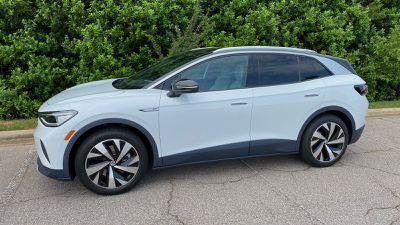
The 2021 Volkswagen ID.4 was launched in a special 1st Edition trim with special badging and other details, and while this was the trim I had on my test vehicle, it has sold out for general customers. VW is currently taking reservations for the mainstream ID.4 launch this summer, which will include two trims, a Pro trim starting at $39,995 and a Pro S trim starting at $44,995. Both of these prices are before potential federal and other tax credits for electric vehicles.
Compared to the base Pro trim, the Pro S trim adds several features such as premium LED headlights, front grill/logo illumination, a panoramic glass roof, easy open/close liftgate, and seat upgrades. The Pro S (and 1st Edition) also includes a larger 12-inch Discover Pro Max infotainment screen rather than the 10-inch Discover Pro screen found on the Pro trim, but VW says the infotainment experience is the same between the two trims aside from the screen size.
Infotainment
The thing that immediately jumped out at me about the MIB3 infotainment system on my ID.4 was its gorgeous 12-inch display. It's a widescreen display with a 20:9 aspect ratio and a resolution of 1920x869 at 175 pixels per inch, which results in extremely crisp text and graphics at the typical viewing distance.
 ID.4 home screen
ID.4 home screenNot only is the ID.4's display beautiful, but it's home to one of the most modern-looking infotainment interfaces I've seen in a car, closely mimicking the experience we've become accustomed to on our phones with a clean look, glanceable app icons, and widget-based home screens. The HERE-based navigation system is main exception to the overall design aesthetic, but most users will likely opt for phone-based navigation anyway.
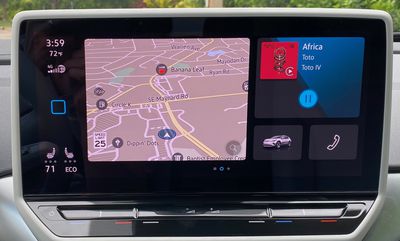 ID.4 infotainment dashboard with widgets
ID.4 infotainment dashboard with widgetsA persistent strip along the left side offers a large home button to exit out of various app functions, as well as status information like time, outside temp, cellular signal strength, and settings for interior temp and heated seats.
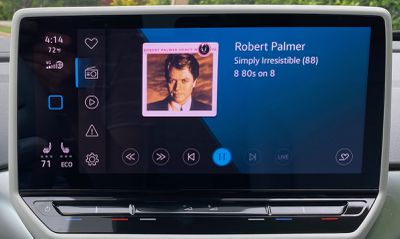 Audio screen on SiriusXM
Audio screen on SiriusXMHome screens can be customized to rearrange app icons in your preferred layout, and there are a variety of color theme options to choose from that give very different vibes for the system.
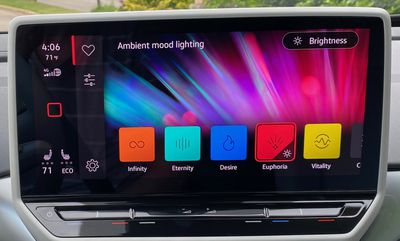 Color theme options for infotainment and interior ambient lighting
Color theme options for infotainment and interior ambient lightingThe ID.4 offers few physical hardware controls, with really only two strips of capacitive buttons below the main screen: The first directly below the display offers quick access to temperature settings for driver and passenger and volume control. The buttons also support swipe actions, so you can easily slide your finger left or right to raise or lower the temperature or volume.
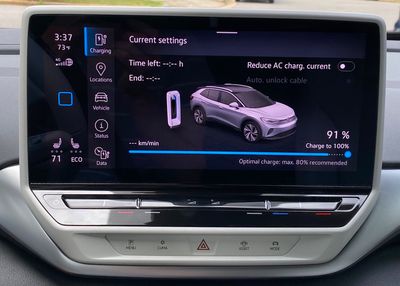 Charging screen with fixed capacitive buttons and sliders below the display
Charging screen with fixed capacitive buttons and sliders below the displayThe second row includes four buttons for accessing parking assist functionality, detailed climate controls, driver assistance technology settings, and drive mode, with the hazard light control in the middle.
And that's pretty much it. There's a cluster of buttons to the left of the driver for headlight settings and quick access to front and rear defrosters, and of course you'll find the usual set of steering wheel and stalk controls, but the center stack is quite sparse. Most buttons throughout the vehicle are capacitive, which feels technologically advanced but which can also make it harder to control by feel.
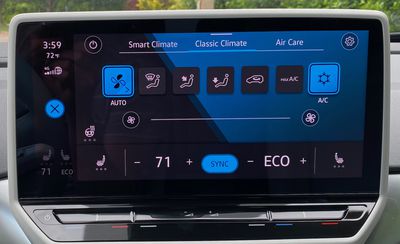 Classic climate controls
Classic climate controlsVolkswagen has pushed things pretty far in its quest for simplicity, and it does result in some compromises such as the climate controls being almost entirely housed in the infotainment system where it can require multiple taps and taking your eyes off the road in order to make adjustments. Easy-access temperature controls and the Smart Climate options help mitigate this, but I still prefer more physical controls I can adjust by feel and a glance.
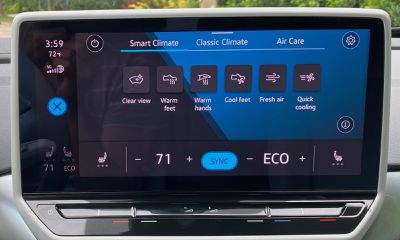 Smart climate controls
Smart climate controlsSome early reviews of the ID.4 mentioned lag in the infotainment system, but I didn't notice any significant issues in that regard. VW tells me it has updated the infotainment system since those early reviews and fortunately, the ID.4 can also receive over-the-air updates so VW can continue to optimize performance going forward.
CarPlay
While Tesla has attracted the lion's share of attention in the electric vehicle revolution, one thing it's missing is support for CarPlay, and that's one area where Volkswagen has gone all-in. The ID.4 supports wireless CarPlay and Android Auto standard, delivering a seamless smartphone experience in the car.
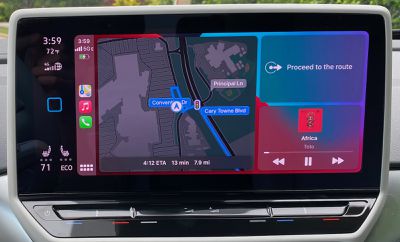 CarPlay dashboard screen
CarPlay dashboard screenCarPlay takes over most of the massive main screen, providing an expansive view that makes things very glanceable to minimize distractions. The status strip along the left side remains active, so you can continue to see some important information from the native system.
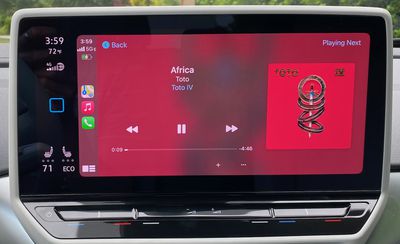 CarPlay "Now Playing" screen
CarPlay "Now Playing" screenThe home button of the native system lets you easily get out of CarPlay and into the regular system, but I do wish it was a little bit easier to hop back and forth between CarPlay and specific native functions like the radio app.
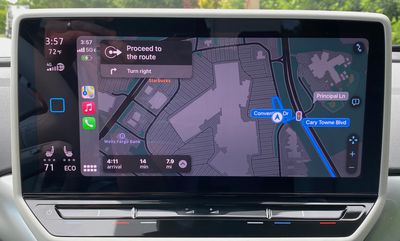 Apple Maps in CarPlay
Apple Maps in CarPlayThe large, high-resolution display is simply gorgeous for CarPlay, especially for navigation apps like Apple Maps and Waze where you can see a tremendous amount of the area around you on the map and card overlays for turns and other information only obscure small portions of the map.
ID. Cockpit
While many vehicles have moved toward expansive digital cockpits in front of the driver, the aptly named "ID. Cockpit" features a remarkably small display that offers only a few key pieces of information. With no need for traditional gauges like a tachometer and engine coolant temperature, an EV can get away with some simplicity here, and the ID.4 does exactly that.
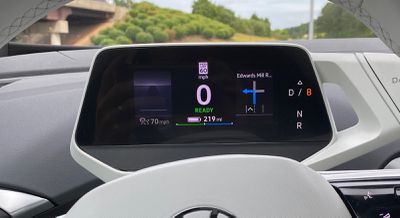 Cockpit screen with native turn-by-turn navigation prompts
Cockpit screen with native turn-by-turn navigation promptsThe ID.4's cockpit screen can be divided into up to three sections with several view options available. The most prominent center section is of course the speedometer (battery range and current speed limit are also shown), while a section to the left can show information on driver assistance technologies like lane-keeping assist and automatic cruise control. A section to the right offers navigation prompts, and yes, as with the VW Tiguan I recently reviewed, this integrates with CarPlay for a second-screen experience when using Apple Maps.
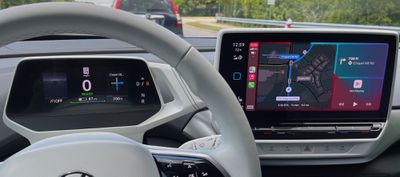 CarPlay Apple Maps with second-screen navigation prompts in cockpit display
CarPlay Apple Maps with second-screen navigation prompts in cockpit displayNavigation prompts include a simple set of arrows with some text describing upcoming movements such as the name of the street and the distance until the movement. It's a simple display, but I appreciate the native look to it that feels like it really fits in with the rest of the information on the screen.
As on the Tiguan, I found that the one missing aspect with CarPlay was lane guidance, which does not appear on the cockpit display, while it does with the native navigation system. Second-screen navigation prompts also do not work with third-party navigation apps like Waze and Google Maps.
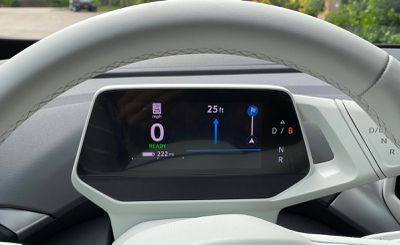 Cockpit display with expanded navigation prompt section
Cockpit display with expanded navigation prompt sectionA pair of View buttons on the steering wheel let you adjust the look of this cockpit display, expanding turning off either the left or right pane while expanding the other one to take up two-thirds of the screen to show more detail.
Other Details
Similar to the Tiguan, the ID.4 includes VW's proximity sensing feature, which lets certain interface elements recede or disappear when you're not interacting with the system, bringing them back to visibility as your hand approaches the screen. This includes elements like text labels on icons and widgets, which in some cases disappear when you're not interacting with the screen, leaving only graphics to provide a cleaner view.
I noticed on the ID.4 that this feature even extends to CarPlay a bit, such as with Apple Maps where information cards like those for search disappear after a few seconds of inactivity. Typically, you need to tap on the screen if you want to bring those back up, but thanks to VW's proximity sensing, they automatically reappear as you reach toward the screen.
The ID.4 also supports some basic gesture controls, allowing you to wave your hand left or right to perform some functions such as swiping between home screen pages and slide-over menus. This functionality does not extend to CarPlay, but I'm still not convinced it's a terribly useful real-world feature, so I don't miss its absence in CarPlay.
As with many vehicles, the ID.4 supports voice control of many functions, and I found the functionality to be fairly flexible. By simply prefacing a request with "Hello ID," you can control vehicle functions or receive information, and it responds to natural language queries with a broad ability for interpreting requests.
For example, you can use Hello ID to open or close the sunshade, set a navigation location, change SiriusXM stations, or even hear jokes. Simply telling Hello ID that you're cold or hot will adjust the temperature settings a bit in the corresponding direction, and with dual microphones, the car can tell whether the driver or passenger is making the request and respond accordingly.
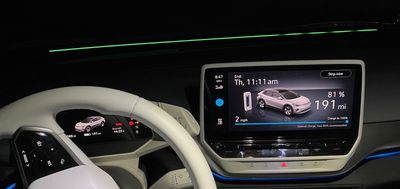 ID. Light showing current battery charge level
ID. Light showing current battery charge levelThe ID.4 also includes VW's ID. Light system, an LED strip that runs along the base of the windshield and which can deliver information to the vehicle occupants. For instance, it shows green while the vehicle is charging with a pulsing portion of it to indicate the current level of charge. It flashes red to alert for emergency braking, can flash green when there's an incoming phone call, and a small portion of it lights up white on either the driver or passenger side when Hello ID voice control has been activated, indicating where it believes the person speaking is sitting.
Wireless Phone Charging and Ports
In addition to wireless CarPlay, the ID.4 also includes a 5-watt wireless phone charger as standard equipment, recognizing the important pairing of these features. The wireless charger is a slot in the center console that mostly tucks your phone out of the way.
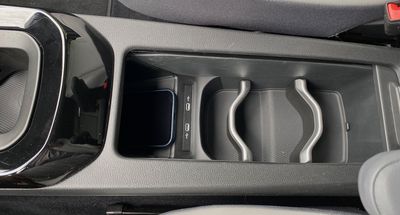 Center console with phone charging slot and two USB-C ports
Center console with phone charging slot and two USB-C portsI initially found the charger to be a bit finicky with my iPhone 12 Pro Max in an Apple MagSafe case, with the system sometimes displaying a warning that the device could not be charged and that I should remove all other items from the charging area even though my phone was the only thing in there. Once or twice the charger also failed to recognize that the phone was on the pad at all and did not initiate charging.
Things got better over the course of my time with the car, so perhaps I just got more familiar with the required positioning for the phone on the pad and it became more natural. The large size of the iPhone 12 Pro Max may also be reducing the margin of error for getting the phone into alignment with the charging coil, but that's just a guess on my part.
VW tells me it has been closely tracking wireless charger performance and feedback and hasn't seen any other signs of problems, so this doesn't appear to be a widespread issue. Regardless, VW says it'll be looking further into the situation to see what it can find.
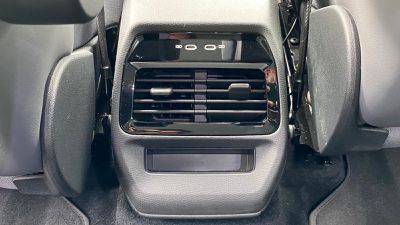 Rear charge-only USB-C ports
Rear charge-only USB-C portsIf you prefer to use a wired connection, the ID.4 is well equipped with a total of four USB-C ports: two charge-and-data ones in the center console adjacent to the wireless charging pad and two charge-only ones on the rear of the console for backseat passengers.
Wrap-up
Volkswagen is just one of many car manufacturers making a push into EVs, and the ID.4 is its most ambitious effort so far. VW has fully embraced the use of technology on that platform, and it's fantastic to see a pairing of a modern infotainment system with standard wireless CarPlay and Android Auto to deliver the best of both worlds to owners.
The 12-inch widescreen display on the Pro S trim is beautiful, and I imagine the 10-inch display on the Pro trim will look nearly as good even at the smaller size. CarPlay looks amazing on the giant screen, and it integrates well with the native system. The second-screen Apple Maps navigation in the digital cockpit is simple but a great feature that I hope will continue to expand across manufacturers and models, and it looks right at home on the ID.4's cockpit display.
Standard wireless phone charging is also something I really appreciate in the ID.4. Even though I experienced a few issues with it in my testing, I wouldn't consider them deal-breakers for me and they may not even affect many users.
























Top Rated Comments
I don't care if it is electric, there's no way I'd ever buy a VW. Between the mediocre engineering and the shoddy build quality they're just terrible cars.